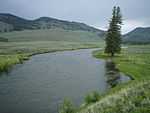Slough Creek is a tributary of the Lamar River, approximately 25 mi (40 km) long, in Montana and Wyoming in the United States.
History
Slough Creek got its name when an 1867 party of gold prospectors ventured into the valley and described its condition as a slough. The name began appearing on maps as early as 1872. A myth associated with the name involves a U.S. Army enlisted man who was escorting an exploring party in 1873 and got lost in the valley. Trumpeter John P. Slough of Company I, Second Cavalry wrote this in his diary:[2]
We attempted to follow the Hayden trail to ascertain where he had crossed the Yellowstone River below the lake. We lost the trail and my Captain Henry E. Noise [Noyes] and my self started to find it the timber and mountains we became lost and on the second day were found by a detachment under Sergeant Kinnoss, and the creek found upon now bears my name (Slough Creek)[3]
Although many have attempted to attribute the name to Trumpeter Slough based on his diary, the name was given in 1867.
Location
It rises in southern Montana, in the Absaroka-Beartooth Wilderness in the Beartooth Mountains, and flows southwest, into Yellowstone National Park and into Wyoming. It discharges to the Lamar River near Tower junction within Yellowstone National Park. In turn the Lamar River forms a confluence with the Yellowstone River inside of Yellowstone National Park. Slough Creek is a mildly alkali watercourse.[4] The Slough Creek watershed consists of mixed fir forest, sage flats and grassland. These plant communities support considerable faunal diversity, including coyote and bison.[5]
| Images of the Slough Creek |
|---|
|
Angling
Slough Creek is one of the most popular fishing areas in Yellowstone Park. The access is relatively easy and the cutthroat fishing is some of the best in the world. The lower meadows of Slough Creek, below the campground, are easily accessible from parking areas between the campground and the Cooke City road. There are rainbows in this lower water as well as cutthroats. The upper meadows of Slough are accessed from a trailhead near the campground. The first meadow is a 45 minute walk from the trailhead. The first meadow is the most popular since it's close and the fishing is excellent. Slough Creek's second meadow is about a 3 hour hike. Cutthroat trout in Slough offer good dry fly fishing with heavy hatches of caddis, pale morning duns, and large Green Drake in July. Terrestrials are prominent in late summer.[6][7]
In the summer of 2007 an angler reported the first rainbow trout to be caught upstream of the Slough Creek falls. The introduction of Rainbow trout may have an impact on both the native Cutthroat trout as well as other wildlife species who count on the Cutthroat as a food source. The National Park service requires anglers to kill any Rainbow trout caught in the river.[8]
See also
References
- ↑ 1.0 1.1 U.S. Geological Survey Geographic Names Information System: Slough Creek, USGS GNIS
- ↑ Haines, Aubrey L. (1996). Yellowstone Place Names-Mirrors of History. Niwot, Colorado: University Press of Colorado. pp. 55–56. ISBN 0-87081-382-X.
- ↑ John P. Slough, Letter to Superintendent Horace M. Albright, August 6, 1922, Yellowstone Park Reference Library
- ↑ Lumina Tech, C.M. Hogan, "Water quality baselines for selected surface waters within the Grand Teton and Yellowstone National Parks" (2007)
- ↑ Wilkenson, Todd, Watching Yellowstone and Grand Teton Wildlife, Riverbend Publishing (2003)
- ↑ Parks, Richard (1998). Fishing Yellowstone National Park. Helena, MT: Falcon Press. pp. 190–94. ISBN 1-56044-625-0.
- ↑ Mathews, Craig; Molinero, Clayton (1997). The Yellowstone Fly-Fishing Guide-A authoritative guide to the waters of Yellowstone National Park. Guilford, CT: The Lyons Press. pp. 77–81. ISBN 1-55821-545-X.
- ↑ "2013 Yellowstone National Park Fishing Regulations". National Park Service. Retrieved 2013-05-20.
|
|---|
|
Geography, historic structures and other attractions in the Tower Roosevelt and Lamar Valley areas | | | Structures and History | | |
|---|
| | Geography and Geology | |
|---|
| |
|



